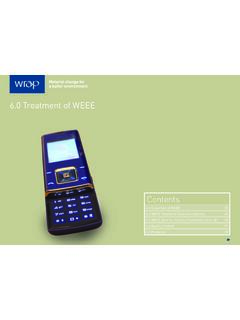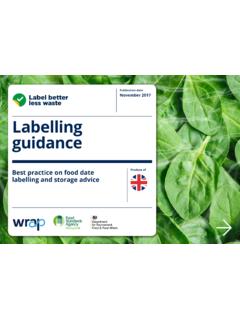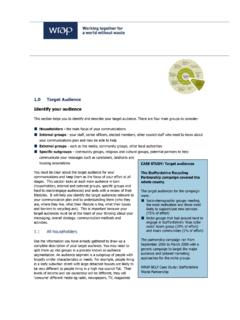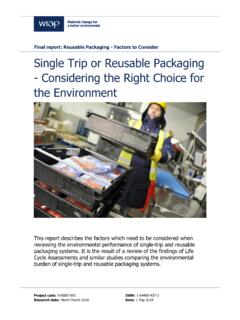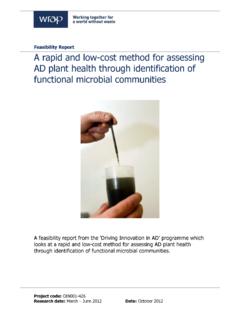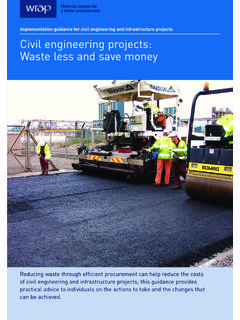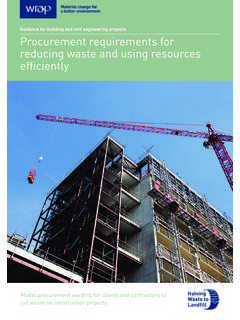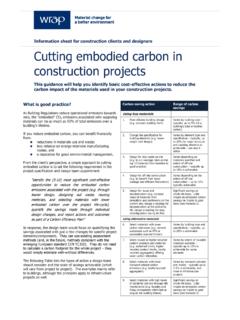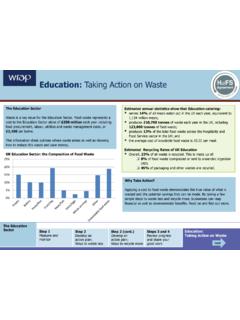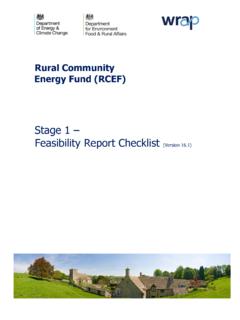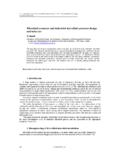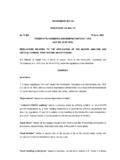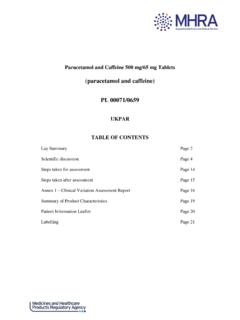Transcription of Final report Efficient use of resources in breakfast ...
1 Final report Efficient use of resources in breakfast cereal packaging design A review of breakfast cereal packaging to understand good practice and to develop a vision for the future that will deliver significant benefits through optimising the use of resources within the supply chain. Project code: RSC003-010 ISBN: 1-84405-424-1 Research date: Date: September 2009 WRAP (Waste & resources Action Programme) helps individuals, businesses and local authorities to reduce waste and recycle more, making better use of resources and helping to tackle climate change. Document reference: Efficient use of resources in breakfast cereal packaging design (WRAP Project RSC003-010). WRAP 2009, Banbury Written by: Vibrandt Form Front cover photography: breakfast cereal from packaging to plate. Any trade marks, copyright material and or intellectual property that is reproduced in the images of packaging shown in this report are not the property of WRAP and WRAP acknowledges the proprietors' rights in such intellectual property.
2 WRAP and 1HQ believe the content of this report to be correct as at the date of writing. However, factors such as prices, levels of recycled content and regulatory requirements are subject to change and users of the report should check with their suppliers to confirm the current situation. In addition, care should be taken in using any of the cost information provided as it is based upon numerous project-specific assumptions (such as scale, location, tender context, etc.). The report does not claim to be exhaustive, nor does it claim to cover all relevant products and specifications available on the market. While steps have been taken to ensure accuracy, WRAP cannot accept responsibility or be held liable to any person for any loss or damage arising out of or in connection with this information being inaccurate, incomplete or misleading. It is the responsibility of the potential user of a material or product to consult with the supplier or manufacturer and ascertain whether a particular product will satisfy their specific requirements.
3 The listing or featuring of a particular product or company does not constitute an endorsement by WRAP and WRAP cannot guarantee the performance of individual products or materials. This material is copyrighted. It may be reproduced free of charge subject to the material being accurate and not used in a misleading context. The source of the material must be identified and the copyright status acknowledged. This material must not be used to endorse or used to suggest WRAP s endorsement of a commercial product or service. For more detail, please refer to WRAP s Terms & Conditions on its web site: Executive summary This study provides guidance on understanding opportunities which may exist for optimisation of resources in the breakfast cereals category. It is aimed at packaging developers, buyers and marketers from brands, retailers and converters within the hot and cold breakfast cereals market. The guidance aims to identify benefits to businesses, consumers and the environment, by creating cost savings, improving distribution efficiency and reducing the amount of food and packaging consumers throw away.
4 The good practice identified in this report could also be applied to other grocery sectors to stimulate new thinking and further dialogue. The study focuses on the largest segments of the category: hot and cold multi-serve cereals. It excludes on-the-go cereals and cereal bars. Examples of current packaging were analysed, and the sector was thoroughly researched including desk-based research and interviews with representatives of the sector, including gaining feedback on the concepts. 430,000 tonnes of breakfast cereals are sold annually in the UK, using around 60,000 tonnes of primary packaging and generating at least 20,000 tonnes of household food waste (Section ). Many opportunities were identified within the breakfast cereal category reducing both the amount of packaging used and the food waste produced, which will result in tangible benefits for the businesses involved, including a reduction in the use of raw packaging materials, and improved pallet and vehicle loads.
5 These benefits could result in a reduction in raw material and distribution costs, and an overall reduction in resources wasted throughout the supply chain. These opportunities centred on the following good practice techniques: Total system: Consider primary, secondary and tertiary packaging as a total system, avoiding functional overlap between the packaging levels and remembering that packaging which remains within the supply chain is more likely to be recovered for recycling than at a household level. See Section 5 Secondary and tertiary packaging , Section 4 Techniques for designing out resource waste and Figure A, below. Waste prevention: Consider the waste hierarchy: prevent, minimise, reuse, recycle, recover, dispose. Favour techniques at the top of the hierarchy, which eliminate valuable materials from entering the waste stream in the first place, for example, component rationalisation, lightweighting, volumetric efficiency.
6 See Section 4 Techniques for designing out resource waste . Food waste: Is predominantly caused by leftovers and spoilage and can be addressed by considering portion control, helping the consumer to recognise and serve the correct amount and reclosable packaging, which may inhibit or delay spoilage. This is detailed in Section Opportunities to reduce food waste from breakfast cereal . Communication: Packaging is ideally placed to carry messages to the consumer both graphically and through text, for example, advising on correct packaging disposal, portion sizes, or the brand s stance on related environmental issues. Communication is discussed in Section 9 Communicating with the consumer and a semiotic analysis of the sector can be found in Appendix 4. These techniques were used to generate concepts which are presented in Sections 6, 7 and 8 moving from optimising current sector practices in Section 6, to learnings from other sectors in Section 7, and on to more radical concepts in Section 8.
7 Figure A shows examples of these concepts. Section 5 Secondary and tertiary packaging highlights the opportunities in improving pallet efficiency, and the impact this may have in reducing storage and distribution costs (see Figure B). The report concludes that there is both a desire and the potential for optimising packaging within the sector through both incremental and radical changes to current packaging formats and that could generate business benefits as well as environmental benefits. A holistic perspective should be maintained; understanding trade-offs between consumer and supply chain packaging and between packaging and food waste. Finally, product suppliers should always be consulted when considering packaging changes, as they have excellent technical knowledge on both product requirements and production capabilities which may be unique to each manufacturing site. Efficient use of resources in breakfast cereal packaging design 1 Figure A Concepts address (L-R) optimisation of the carton by reducing flaps, seal reduction on cereal bags, reusable crates which can be used at point of sale, and even product developments which enable the cereal to be packed more compactly, or kept fresher for longer.
8 See Sections 6, 7 and 8. Figure B How primary pack design can affect pallet and distribution efficiencies (see Section 5) Efficient use of resources in breakfast cereal packaging design 2 Contents Introduction .. 6 Who should read this document ..6 Aims ..6 Packaging and food About the Background to packaging and food waste 7 Drivers for resource optimisation and waste reduction ..7 Opportunities to reduce food waste from breakfast Market context .. 9 Types of Growth drivers ..9 Category Techniques for designing out resource waste .. 10 Waste prevention ..10 Reuse .. 11 Recycling .. 11 Techniques 11 Secondary and tertiary packaging .. 12 Balancing primary and secondary packaging 12 13 Reusable transit 14 Secondary and tertiary packaging 14 Optimising existing breakfast cereal formats .. 15 Bag-in-box .. 15 Volumetric efficiency.
9 15 Carton joint reduction .. 18 Liner bag seal reduction .. 19 Material choice, weight and recycled content of cartons and liner bags .. 19 Removal of material from the carton .. 20 Removal of the liner bag .. 21 Bag-in-box 21 Standalone (FFS) 22 Seal 22 Material lightweighting .. 22 Material selection .. 23 Secondary packaging and point of 24 Hybrid bag and box solutions .. 25 Introducing packaging formats from other applications .. 26 Stand-up pouches (SUP) .. 26 PET or rPET .. 26 Box-in-bag .. 27 Innovating revolutionary cereal packaging systems .. 28 Controlled pour .. 28 Single serve packaging .. 29 Dosing .. 30 Reclosures .. 32 Self-dispensing .. 34 Communicating with the consumer .. 36 Consumer misconceptions .. 36 On-pack communication and consumer behaviour .. 36 Semiotic guidelines and trends .. 37 Summary .. 38 Appendix 1 .. 39 Study methodology.
10 39 Efficient use of resources in breakfast cereal packaging design 3 Initial research .. 39 Initial ideation .. 39 Development of interview 39 Telephone interviews ..39 Interview 39 Concept development and finalisation .. 39 Appendix 2 .. 40 Legislative drivers further information on Section .. 40 Appendix 3 .. 41 Packaging requirements .. 41 Industry stakeholder requirements .. 41 Consumer demands .. 42 Appendix 4 .. 43 Semiotic Guidelines and trends continue from Section .. 43 Semiotic 43 Interesting opportunities .. 43 Areas to 43 Semiotic codes in the category .. 45 Trends .. 46 Figures Figure A A selection of concepts from Sections 6, 7 and 8..2 Figure B How primary pack design can affect pallet and distribution efficiencies (see Section 5) ..2 Figure 1 Quaker multipacks prescribe portion size. The Archer Farms pack features reclose lid..8 Figure 2 My Muesli (left).
